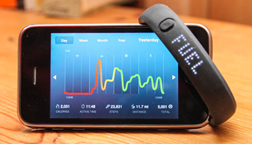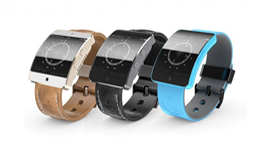mHealth Monthly Mashup: Release 25.0 – watching out for the iWatch and the next revolution in wearable tech

In this month's mashup, Michael Spitz takes a look at the wearable device trend, focusing on the imminent "iWatch" revolution...
The destiny of tech companies is written in their strategy: Apple defeated both Microsoft and Dell because Bill Gates focused entirely on software, Michael Dell on hardware, while Steve Jobs stubbornly worshipped the seamless synergy between software, hardware, and user.
Fast forward to mobile and the battle lines have shifted from integration to implementation: Every user experience has become Apple standard or a generic variant, so the fight now is for dominant market share across an iconographic, app-driven sea of homogeneity.
Fresh competitive strategies have taken two approaches, both failing: 1) cut the price on a premium brand (the horrifically commoditized Apple iPhone 5c), or 2) create a whole new device line extension (the embarrassingly glitchy Samsung Galaxy Gear smartwatch).
While Jobs surely rolled in his grave as bright pink and yellow plastic iPhones shipped and bombed, the "smartwatch" nonetheless remains a viable next generation wearable device. Despite the many false starts and overt failures, sheer expedience dictates its inevitability.
But what do we actually mean by "smartwatch"? And how has its arduous and still incomplete development been dependent on composite factors, including tech limitations, connectivity, and user behaviors? Answers suggest our First Truism of Smartwatches:
Smartphones RIP
"Some rise by sin, and some by virtue fall," wrote the Bard, now stubbornly applicable to smartphones, measure for measure and eminently doomed to die like their landlocked rotary dialing dinosaur forebears. Portability is terrific, but the overall experience sucks.
Deconstructing the user flow of your typical smartphone, an astonishing seven or so steps separates the ask from the data: 1) Reach into pocket; 2) Grab phone and tilt; 3) Access screen; 4) Enter password; 5) Scroll through apps; 6) Tap app; 7) Interact #Absurd!
Now consider a "smartwatch" or equivalent wearable edevice: 1) Lift arm; 2) Scroll; 3) Tap; 4) Interact #Better! Throw mhealth into the mix, and you take advantage of several technical and user experience opportunities, as body sensors become part of the device itself.
Benefits have not gone unnoticed, especially since health and fitness needs drive more than 40% of consumers to consider smartwatches. Let's see how major players like Apple, Samsung, Sony, and Nike respond, plus quirky startups and the VC capital fueling them.
Trendsetter: Digital Wrist Bands
Micro-computers began in the form of monstrous vacuum tube-laden building-sized behemoths, so we can't start talking about smartwatches and health without paying homage to their great granddaddy, arguably the Nike Fuel Band. Not only did it work, but it sold.
Successively elevating "Just Do It" from rubber on your feet, to tools for victory, to personal expressions of excellence, the next powerful step for Nike was to create a popular mhealth device that measured, managed, and motivates your journey of physical self-actualization.
Fitbit and others have broken similar ground, but Nike was the first and best at not only designing and developing a wearable device, but creating a multichannel integrated infrastructure: Desktop experience, smartphone and tablet app, fueled by game incentives.
Such integration also took the heat off the wristband itself: Unable to do it all, the band is essentially a biomeasurement tool that communicates with other interconnected devices that pack more processing punch—which leads to our Second Truism of Smartwatches:
Healthtracker / smartphone crossovers![]()
Similar to how tablets bridge the divide between laptops and smartphones, the "smartband" offers the functional features of a smartwatch with the fitness utility of a dedicated health tracker. Case in the point, Samsung's new "Gear Fit" hybrid.
Equipped with a pedometer, heart rate monitor, and exercise algorithms, the device also pairs with the Galaxy smartphone to display calls, texts, and even synched meeting invites. Given these capabilities the Gear Fit clearly supplements rather than replaces existing tech.
Considering Samsung's initial smartwatch failure (and lackluster relaunch), this crossover makes sense, provides value, and could gain some traction. What's particularly interesting is how mhealth has actually spearheaded mobile wearables, precipitating these tech combos.
"Adding pressure into the mix is the incredible remote patient monitoring market, predicted to double to over $20 billion by 2016."
Adding pressure into the mix is the incredible remote patient monitoring market, predicted to double to over $20 billion by 2016. Here the idea of a hybrid device that measures, messages, and motivates via vitals is key, leading us to our Third Truism of Smartwatches:
"Soon biometrics from a mobile device will be a mandatory functional requirement, as payers, providers, and professionals increasingly demand patient data."
From Smartwatch to iWatch
Apple gets it, as is already on it. Jobs' glaring innovative absence notwithstanding, rather than release a dud they have paced themselves. They also now recognize the inherent and central value of mobile health, and have recruited top talent to help get it right.
Their commitment to mhealth seems to go beyond iWatch development, with reports suggesting iOS 8 will have a distinctly mhealth focus. Featuring a "Healthbook" app and built-in sensors, the iPhone itself will play a pivotal role as both monitor and processor.
What's cool is how Apple plans to bring all these evolutionary threads together: Refreshed, mobile health-enabled operating system, smartphone upgrades, and introduction of the new "iWatch" as an optimized hybrid—leading us to our Fourth Truism of Smartwatches:
"Leading the smartwatch charge are tech giants, eventually penetrating the mobile health space so deeply they transform into healthcare companies."
Seeking "The One"
As mhealth enthusiasts our goal is the quantified self, realized at least asymptotically with the complete and seamless monitoring, analysis, and data visualization of all our vitals. Getting there is clearly iterative, represented by these imperfect but captivating prototypes.
The bottom line is that creative vision and user expectation still outpace technical capabilities. The potential market is vast, but even giants like Google have only dipped their toes into smartwatches, recently throwing it right out with the Motorola bath water.
 Remember the Apple Newton? Great idea, lousy experience. The vision was there, but the ability to bring it to life was still years away. Short of brain shunts found in THE MATRIX we want a wearable that's strong, user-friendly, and packed with biometrics.
Remember the Apple Newton? Great idea, lousy experience. The vision was there, but the ability to bring it to life was still years away. Short of brain shunts found in THE MATRIX we want a wearable that's strong, user-friendly, and packed with biometrics.
Tech aside, users need to adjust back to wristwatches the same way they adjusted away from smartphones. Smartphones killed watches because they could tell perfect GPS time; smartwatches will only kill smartphones if they can outperform all their functionality.
"...smartwatches will only kill smartphones if they can outperform all their functionality."
Classic example is Facebook, a "me too" social network after Friendster and MySpace. Zuck's genius was to create a consistent interface with no down-time. His updates oscillated smoothly with shifting user behaviors, suggesting the Fifth Truism of Smartwatches:
"Getting the smartwatch user experience right is extremely difficult but only half the battle, since user behaviors must evolve in lock step, chicken-before-the-egg."
From Smartwatch to Smartwearables
Seeing the future is relatively easy, but actually delivering on the vision is the ticket. Who gets there first and best will not only lead the charge in mobile health, but akin to Apple, Microsoft, Google, and Facebook transform how we all communicate and live.
That all said, more than million "smartwatches" have already shipped in 2013. Hundreds of startups, with 10 particularly interesting ones already lick at the innovative heels of the tech giants. With a phone or without, our wrists will be smarter—and our bodies healthier.
Just as the basic feature set of a "smartwatch" will likely vary from platform to platform, manufacturer to manufacturer, and brand to brand, other types of wearables from necklaces to clothes to contact lenses will prove increasingly viable.
Consider Sony's "smartwearables" that redefine the channel and beg the question of conventional categorization. Extrapolate that trend and the already horribly clichéd "Internet of Things" (everything is connected) suggests the Sixth Truism of Smartwatches:
"The first commercially successful smartwatch will not only revolutionize mobile health, but will create a 'smartwearable' category ultimately linking the human body to the Web."
Conclusion and Summary
We live in auspicious times, especially for mobile health. The evolution from desktop to laptop to smartphone to tablet has been rapid and astonishing, but is only the first steps along a digital journey culminating in comprehensive, real time, seamless connectivity.
The "smartwatch" is therefore more than a prototype concept, or the next consumer electronics fad. Instead, the device in all its variants represents a paradigm shift from tech that's an external object to one that's attached and essentially part of the human body.
The engineering and behavioral modification required to embrace smartwearables is a steep cliff with a gaping chasm, but once climbed and crossed mhealth will finally go mainstream in a way that's truly transformative, leading to our Seventh and Final Truism of Smartwatches:
"The 'smartwatch' is the gateway device to the quantified self."
What do you think?
1) We need to redefine what we mean by a 'mobile device'.
"We need to redefine what we mean by a 'mobile device'."
2) Wearable devices are always connected to a broader data platform.
3) The healthcare community will demand that these devices have increasingly powerful biometric capabilities.
4) Apple, Google, Samsung et. al will get so vested in mobile health that they'll transform into healthcare companies.
5) But getting smartwearables right is really hard, especially since mobile users will have to change their habits and tolerance for data sharing.
6) The first successful smartwatch will create a new 'smartwearable' category connecting the human body to the Web.
7) Hang on to your hats, that seamless connection will eventually and inevitably lead us to the "Quantified Self".
Do you think the time is now?
About the author:
Michael Spitz is VP of Strategy at Klick Health, wbere he combines his passion for technology with more than 15 years of clinical content expertise to help engineer digital healthcare solutions. Follow @SpitzStrategy on Twitter for his daily – often hourly – updates on all things digital for the ultimate benefit of patients worldwide.
Closing thought: What do you think is the commercialization of mobile health?












